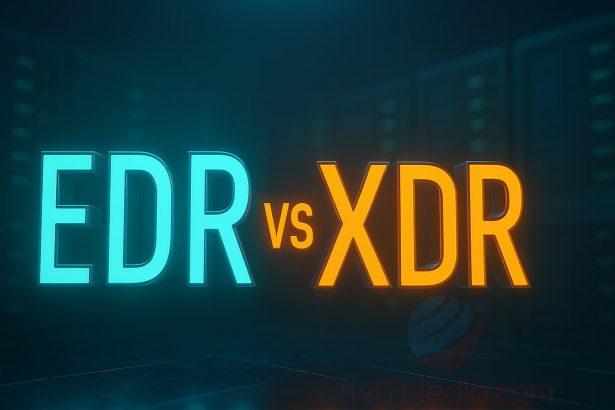Cyber threats are growing more advanced every day. For small to medium-sized businesses (SMBs), choosing the right defense can mean the difference between a quick recovery and devastating losses. If you’re comparing EDR vs XDR, you’re already on the right track.
Both Endpoint Detection and Response (EDR) and Extended Detection and Response (XDR) are powerful tools—but they serve different purposes. Understanding these differences will help you make the right investment in your company’s cybersecurity.
Protect Your Business’ Cybersecurity Now!
Protect your business from evolving cyber threats with our tailored cybersecurity solutions designed for companies of all sizes. From malware and phishing to ransomware protection, our multi-license packages ensure comprehensive security across all devices, keeping your sensitive data safe and your operations running smoothly. With advanced features like real-time threat monitoring, endpoint security, and secure data encryption, you can focus on growth while we handle your digital protection. **Request a free quote today** for affordable, scalable solutions and ensure your business stays secure and compliant. Don’t wait—get protected before threats strike!
What Is EDR?
Endpoint Detection and Response (EDR) is a cybersecurity solution focused on detecting and responding to threats at the endpoint level—like laptops, servers, and workstations.
Key Features of EDR:
- Real-time endpoint monitoring
- Threat detection and alerting
- Incident response capabilities
- Forensic investigation tools
- Behavioral analysis
EDR is ideal for businesses looking to strengthen their defense at the individual device level. However, it operates in a silo—meaning it monitors each endpoint without correlating data from other sources.
What Is XDR?
Extended Detection and Response (XDR) takes EDR a step further. It aggregates data across multiple security layers—not just endpoints but also networks, servers, cloud environments, and email systems.
Key Features of XDR:
- Cross-layer threat detection
- Integrated telemetry from multiple tools
- Unified incident response
- Automation and analytics for faster resolution
- Broader visibility into the entire IT ecosystem
With XDR, businesses get a centralized view of all threat activity, helping security teams detect complex attacks that span across different vectors.
EDR vs XDR: Key Differences
| Feature | EDR | XDR |
|---|---|---|
| Scope | Endpoints only | Endpoints + Network + Cloud + Email |
| Visibility | Device-level | Organization-wide |
| Data Correlation | Minimal | Integrated and automated |
| Threat Detection | Focused on endpoints | Context-aware, across vectors |
| Response Capabilities | Manual or semi-automated | Automated, coordinated |
| Complexity | Easier to deploy | More complex but more powerful |
| Cost | Lower upfront | Higher ROI in long-term security |
Which One Is Right for Your Business?
Choose EDR If:
- You’re a small business with a limited IT team.
- Your primary concern is securing laptops and desktops.
- You want a cost-effective solution to start with.
Choose XDR If:
- You have a more complex IT environment (e.g., remote teams, cloud apps).
- You need holistic threat detection and response.
- You’re already using multiple security tools and want to centralize them.
Real-World Example
A marketing firm with 20 employees used EDR to monitor its office computers. But when a phishing attack infiltrated their email and cloud drive, the EDR solution didn’t catch it. After switching to an XDR platform, they gained visibility across email, cloud storage, and endpoints—preventing similar threats in the future.
Cost and ROI Considerations
EDR tools are typically less expensive upfront and easier to manage, making them suitable for smaller teams. XDR, while costlier, reduces time to detect and respond (MTTD/MTTR), cutting long-term losses and downtime. Think of it as investing in proactive rather than reactive defense.
Enhance Your Protection with Multi-Device Anti-Malware
Whether you choose EDR or XDR, don’t forget the basics—robust anti-malware protection across all your business devices. SpyHunter’s multi-license option is an affordable way to secure multiple endpoints with one license, ideal for SMBs needing reliable malware defense.
Conclusion: EDR vs XDR – A Strategic Choice
When it comes to EDR vs XDR, the choice depends on your business size, risk profile, and infrastructure. EDR is a solid foundation, while XDR offers a more integrated, future-ready defense.
Take the next step: Invest in layered protection and multi-device anti-malware with SpyHunter’s multi-license offering to protect your business from evolving threats.
Protect Your Business’ Cybersecurity Now!
Protect your business from evolving cyber threats with our tailored cybersecurity solutions designed for companies of all sizes. From malware and phishing to ransomware protection, our multi-license packages ensure comprehensive security across all devices, keeping your sensitive data safe and your operations running smoothly. With advanced features like real-time threat monitoring, endpoint security, and secure data encryption, you can focus on growth while we handle your digital protection. **Request a free quote today** for affordable, scalable solutions and ensure your business stays secure and compliant. Don’t wait—get protected before threats strike!




